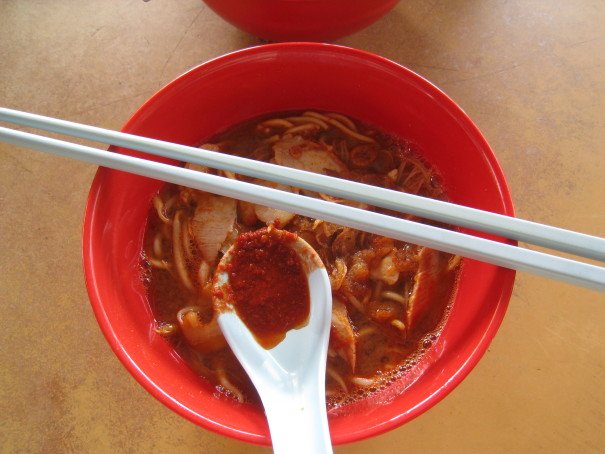
A Breakfast Soup Worth Suffering For

A Breakfast Soup Worth Suffering For
Hokkien mee in Penang
The humidity is ever present in Malaysia. You feel it as soon as you step out of the air-conditioned airport. The air sticks to your body like caramel candy. In Penang, an island off the northwestern coast of peninsular Malaysia, the sun rises at around a quarter past seven and by eight, the humidity is already at, or close to, full power. Accustomed to bone-dry Melbourne summers, I just can’t take it.
Thus, one would think that the last thing I would choose to do at 8:30 am in Penang is sit under a rusty corrugated iron roof and slurp a chili-laden orange-red broth. But that’s exactly what I did the last time I was in Penang. The broth found under that rusty roof is that good. I’d down a bowl of it over a live volcano.
The broth I speak of belongs to a dish known simply as Hokkien mee in Penang. Like so many iconic Malaysian hawker dishes, the phrase Hokkien mee has entirely different meanings depending on which part of the country you’re in. Mee is the Hokkien word for noodles, and, as the dishes’s name implies, the only major common denominator in the different regional iterations of Hokkien mee are the noodles themselves. Hokkien noodles are thick, yellow, cylindrical egg noodles the approximate size and shape of spaghetti.
In Penang—the place where most Malaysians and Singaporeans will tell you the region’s best hawker food is found—Hokkien mee refers to a dish consisting of hokkien noodles and thin vermicelli rice noodles served in a bowl of slow-cooked, orange-red prawn soup made using prawn heads and shells, pork ribs, rock sugar, and salt. The dish is topped with various cooked ingredients before serving, including kangkong (water spinach), bean sprouts, thinly sliced lean pork, sliced hard-boiled eggs, fried shallots, and peeled prawns.
Penang Hokkien mee is most commonly eaten for breakfast, whereas, for example, Kuala Lumpur Hokkien mee, a stir-fried dish, is typically eaten for lunch or dinner. In the rest of Malaysia, the dish known in Penang as Hokkien mee is often called hair mee (the Hokkien phrase for “prawn noodles” that, somewhat confusingly, is often spelt har mee) or har meen, which is Cantonese for “prawn noodles.”
My favourite Hokkien mee in Penang can found in the kopitiam—the local word for “coffee shop,” a portmanteau of the Malay word for “coffee,” kopi, and the Hokkien word for “shop,” tiam—at the corner of Jalan Perak and Jalan Kebun Nyiur. The Hokkien mee hawker who’s set up his stall there starts selling his Hokkien mee at around 7 am and keeps selling it until he runs out, which usually happens at around 10 am.
A few weeks ago, I arrived at the kopitiam at around 9 am with my aunt and joined the throng of half a dozen people milling about waiting for a table. I was beaten to two tables before I finally nabbed one: a circular, metal table located not in the kopitiam itself (where there was the blessed relief of ceiling and portable fans), but in the adjacent, outdoor area covered by a rusty corrugated iron roof where there were no fans.
My Hokkien mee arrived in a red plastic bowl of the kind commonly used by hawkers in Malaysia and Singapore—thick, opaque and built to withstand casual tossing—with the obligatory spoonful of fresh chili paste. The Hokkien mee was the same as it’s always been. I mean that as a compliment—this hawker’s quality control would do any Michelin-starred restaurant proud. Somewhat controversially, he has always omitted, and continues to omit, three traditional ingredients: kangkong, sliced hard-boiled eggs and bean sprouts. Those omissions, along with his premium pricing, has led some Penangites to disdain his Hokkien mee.
I could not disagree more with their opinion. His version may not come with any large peeled prawns to justify the premium price, but it sells out every morning for one simple reason: the soup. His is the best on the island—a masterful balance between prawn and pork, sweet and savory; suffused with an intense, prawn-fueled umami flavor, yet still light enough for breakfast.
I’ve been eating his Hokkien mee for nearly 10 years, and after finishing a bowl, I always have the same thought: I want more.